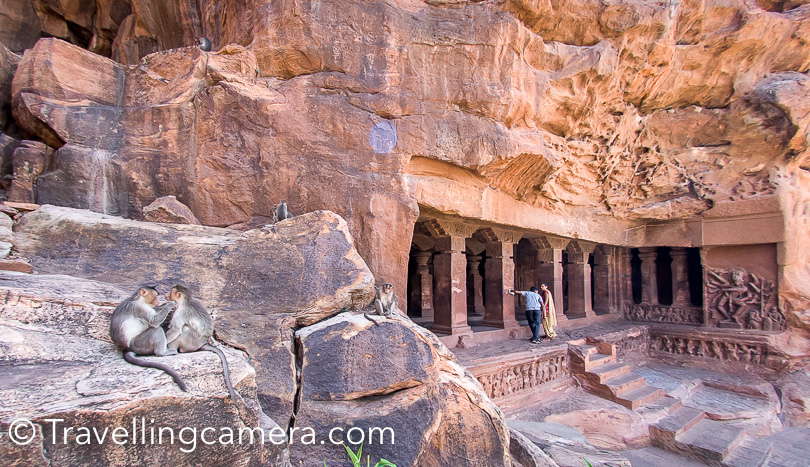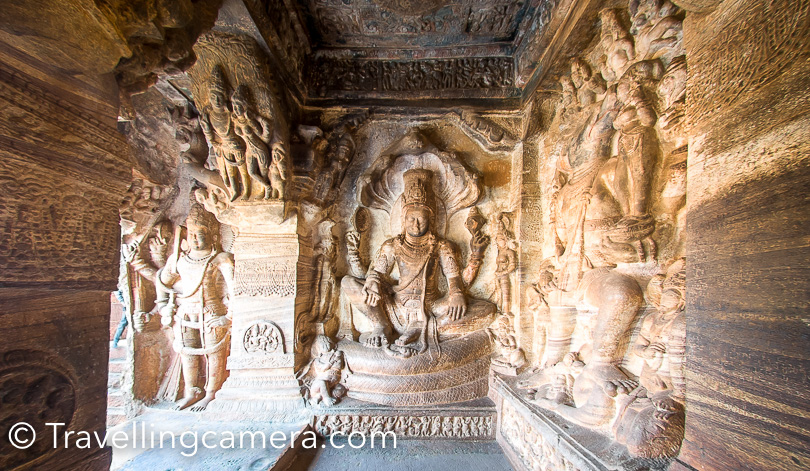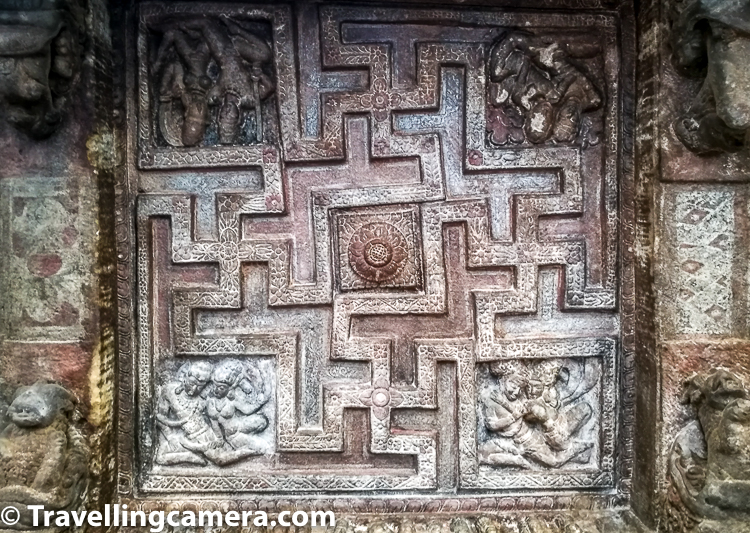Badami - Regal capital of the Chalukyas and a ravine at the foot of a rugged, red sandstone outcrop that surrounds Agastya Lake
Badami cave temples are mentioned whenever we talk about Indian heritage, art forms, old temples and some unimaginable work which is worth sharing with the world. Many people who want to explore the heritage of India and it's history certainly visit Badami cave temples which was very unique and well preserved so far. Apart from these cave temples, Badami and surrounding areas have a lot to offer. Here we are trying to share more about Badami Cave Temples and other important places to explore around Badami region of Karnataka in India.
Badami is in Bagalkot District of Karnataka State.
Badamai Cave Temples are most popular places to explore in this region. They are special because all these 4 temples are carved out of huge red Stone Mountain in Badami. Out of these 4 cave temples in Badami, 3 are dedicated to Shiva and Vishnu, while the 4th one is dedicated to Jainism. Each cave temple of Badami has brilliant carvings and intricate art-forms on walls, pillars & ceilings It's hard to imagine how people would have carved temples & god forms to depict stories.
Wondering if there are artists in India who can create such things today and if government or other organisations are supporting these initiatives. While sitting at home and seeing these things on TV may not create much excitement, but when you are there lot of such thoughts cross your mind and you feel like there must be some ways in modern times to leverage such brilliant skills of artists/specialists.
Note the dancing shiva in the first photograph which is clicked near first cave in Badami. I am counting the 1st cave on the basis of cave which comes the first after climbing those red stone stairs around this monument and a heritage site.
Time needed to explore Cave Temples : 2-3 hrs
Entry Ticket Fee : 25 Rs for Indians and 200 Rs for Foriegners ($3)
Badami Fort was built by Tipu Sultan in 18th century and it has few watchtowers and 2 shiavalayas. Few other essential things include Durga Temple, Lad Khan Temple, Ravanaphadi Cave Temples, Huchimalli Temple, Meganagudi group of temples, Gowda Temple & lot others.
Badami was earlier known as Vatapi and is a historically significant place with a lot of heritage structures.
Badami was the capital of the Chalukyas. The Badami Fort was the residence of the Chalukyan rulers. The fort was acquired and destroyed by the Pallavas later on. Much later, when Badami came under the rule of Tipu Sultan, the walls of the fort were rebuilt and several structures were added to the ancient fort complex. When you are in this part of India, you will find various structures built, rebuilt or changed by Tipu Sultan. During the trip to Badami, our guides shared a lot about how various kingdoms played role in Karnataka state, but I feel like doing a revision either through another visit or finding a good documentary on this.
The Badami Fort was built in the Chalukyan style of architecture. The fort is surrounded by double fortification walls and structures within the fort offer a glimpse of the architectural grandeur prevalent during the Chalukyan reign. The entrance of the fort is guarded by a statue of Nandi, Lord Shiva’s bull. You will find Nandi in various architectural sites of Karnataka state including Belur, Halebidu, Badami & Pattadakal.
There is a mosque like structure in the centre of the fort, which is believed to have been constructed by Tipu Sultan.
Timings of Badami Fort in Karnataka - 6am to 6pm
Ticket fees for entry to Badami Fort - 5 Rs
Photography is allowed inside Badami Fort in Karnataka (as of 2017)
Bhuthanatha Temples is located around the beautiful Agstya lake in Badami and it's mainly dedicated to lord Shiva. This temple is made up of sandstone, which is locally available in Badami area of Karnataka state in India.
There are two major temples here in this complex of Bhuthanatha Temples. First temple on the east side of the lake is called the Bhutanatha temple which has a superstructure that resembles early South Indian style or North Indian style with its open mantapa extending into the lake.
Second temple in this complex is on the north-east side of the lake which is called the Mallikarjuna group of temples. Mallikarjuna temples have a stepped superstructure which is commonly found in Kalyani Chalukya constructions.
Bhutanatha temple contain architectural forms from different periods as it's built over the years and changed by different dynasties who ruled Badami in the past.
Open Air Museum is another interesting place in Badami which has 4 separate section and 2 of them are open air. This museum has plenty of things from mythological & pre-historic era. This part of South India has certainly lot to explore & impress.
In above photograph, Vishu is sitting on Adisheesha. This is clicked at Cave temples of Badami.
Bhanshankari Temple is also located in Bagalkot district of Karnataka. This is considered as one of the important shrines in Karnataka state of India.
Vellamma temple in Badami is another place to visit in this area.
After exploring Badami, I am most impressed by Cave Temples.
You can notice a mosque between these 2 rocky mountains. It's called Mosque of Badami in Karnataka state of India. This is close to the entry gate of Cave temples and the bus stand.
Agstya Lake is considered as a holy lake of Badami which faces famous cave temples of Badami. Apart from caves, this lake is surrounded by redstone temples & the mosque of Badami. While we were walking around the caves, this lake was clearly visible from cave-2 and beyond. It was certainly a good place for many of the co-travellers to get a photograph clicked.
If you notice, there are various things designed on roof-top as well in Badami. I noticed Brahma on Hamsa in cave-3 on the ceiling. We have shared some of the ceiling photographs at the bottom of this blogpost.
Aihole in this region is a store of temples & heritage. Aihole has plenty of temples and ruins spread over the town and that makes it very special. It's also advisable to accompany a guide who can share about Aihole it's history and how it transformed over a period of time.
During this post we also promised about sharing some of the most stunning ceilings we saw in Badami region. So make sure you look up when you are visiting these places in Badami.
Creative Ceilings are one of the favourites of Travellingcamera and we have been sharing some posts specially dedicated to such creativity. Most of these ceilings in Badami are influenced by religious faith and beliefs. We loved the Brahma on Hamsa in cave-3 of cave temples on the ceiling but not just that.
Note the dancing shiva in the first photograph which is clicked near cave-1 in Badami.
The ceilings show Vedic deities such as Agni and Indra, along with Brahma, Vishnu and Shiva. Other deities displayed include love god and goddess Kama and Rati respectively, as well as Nayikas with various emotional expressions. The carvings show the same vahana for the various gods and goddesses that are found in contemporary Hinduism. Evidence of pigment remains have survived and are visible in the ceiling. It is likely that the ceiling was elaborately painted like those in Ajanta Caves of Maharashtra.
In above photograph, Vishu is sitting on Adisheesha. This is clicked at Cave temples of Badami.
Cave 3 also shows fresco paintings on the ceiling, some of which are faded and broken. These are among the earliest known surviving evidence of fresco painting in Indian art. The Hindu god Brahma is seen on Hamsa vahana in one of the murals. The wedding of Shiva and Parvati, attended by various Hindu deities is the theme of another.
Other places to explore around Badami town of Karnataka:
If you liked this post and found it helpful, I would request you to follow these things when traveling -
- Manage your waste well and don’t litter.
- Use dustbins. Tell us if you went to a place and found it hard to locate a dustbin.
- Avoid bottle waters in hills. Usually you get clean water in hills and water bottles create lot of mess in our ecosystem.
- Say big no to plastic and avoid those unhealthy snacks packed in plastic bags. Rather buy fruits.
- Don't play loud blaring music in forests or jungle camps. You are a guest in that ecosystem and disturbing the locals (humans and animals) is not polite.




















.jpg)
Comments